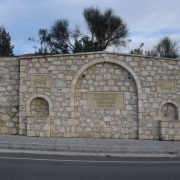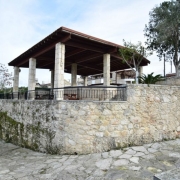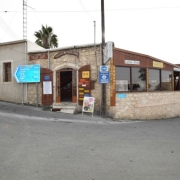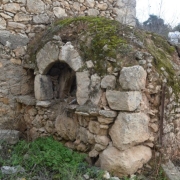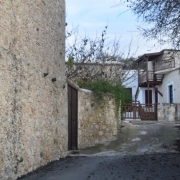Lysos is located approximately 36 kilometers northeast of Paphos. Territorially, it is the largest village in the Paphos district and perhaps the entire country of Cyprus, it is built at an average altitude of 560 meters and borders the villages of Kampos, Tsakistra to the east, Frodisia and Livadi to the north, Galia, Argaka, Kinousas and Pelathousa to the northwest, Steni, Peristerona and Meladia to the southwest, Melandra, Zacharia, Kio, Sarama, Anadiou, Pano Panagia to the south and is adjacent to the village of Kritou Marottou.
The highest point of the village is Tripylos (1,362 meters) and is located in the easternmost part of the village, in the area of Stavros tis Psokas.
Most of the village’s territory is covered by forest and wild vegetation. It is a habitat for wild and various other rare birds. There are remarkable nature trails in the area where visitors can see unique plants, birds and reptiles.
The Forestry Department is located in Stavros tis Psokas and there is also a wonderful camping area. A similar area exists in Agios Merkourios, which is no less beautiful in terms of natural beauty.
In Lysos, figs, cherries and other fruit trees, olives, carobs, citrus fruits, legumes, grains and a few vegetables are cultivated. However, the largest area of the village is uncultivated and in it grows wild natural vegetation such as pines, xistarkes, latzias, cedars and others. The largest part of the administrative area of Lysos is occupied by the state forest of Paphos.
In terms of transportation, Lysos is connected by road to Polis Chrysochous via the Meladia-Peristerona-Steni road. To the northwest it is connected to the village of Pelathousa and from there to Polis Chrysochous. To the northeast it is connected to Stavros tis Psokas, the Monastery of Kykkos and from there to the mountain resorts of Troodos.
The name Lysos has ancient origins and is associated with ancient Greek settlements of Asia Minor, whose settlers transferred ancient names to Cyprus. Lisos or Lissos was also the name of an ancient city in Crete. There is another version that is not excluded from being true and states that the name Lysos comes from the verb λύω (to melt), because Lysos, due to the abundant water it had in the past, but also the copper-bearing layer located in the area of the western side of Troodos, was used as a factory for melting metals.
There is no doubt that the village was inhabited by the ancient Greeks. The geometric vases, the rock-cut tombs and other findings found in archaeological sites in the area testify to this. Over the centuries, Lysos has maintained its national and Greek identity unchanged without allowing its national character to be altered. The fidelity of the various toponyms is also confirmed by traditions, such as the presence of Medieval Digenis, with Digenis’s foot, Petra tis Chartzii, etc.
In the national struggles, the presence of Lysos was particularly active. It was the first of all the communities in the Paphos district to start organizing guerrilla groups from the surrounding area. During the struggle, several residents of the village were political prisoners in the Kokkinotrimithia and Pyla detention centers. In the liberation struggle of the EOKA, there were shelters and bases for the organization’s guerrillas. The hero student-poet Evagoras Pallikaridis operated and was arrested in Lysos. The areas where the guerrillas operated are known as the EOKA lairs and are located 3 kilometers from the village towards Stavros tis Psokas.
The local authorities, in cooperation with the Council of Historical Memory of the EOKA Struggle (SIMAE) restored the hideout in the “Proseuchi” area where Evagoras Pallikaridis lived with other fighters. There are other hideouts in the village area that are waiting for their turn to be restored and their history preserved.
In Lysos, the visitor can admire the unique natural environment in the area of Stavros tis Psokas, the Byzantine Church of the village which has an ancient Byzantine fresco in the blind window of the sanctuary, the frescoes in the chapel of Agios Georgios, the church of Agios Raphael Nikolaos and Irene, Agios Konstantinos, Archangel Michael, Prophet Elias, Agios Nikolaos, Agios Charalambos, Agios Merkourios, Agia Marina, Agios Mavros, Agioi Saranda (ruined today) as well as many other sights.
The village is also known locally for its unique, traditional delicacy of “Maxilles” – a type of dried fig that is consumed as a sweetener, or eaten in combination with almonds or walnuts.


